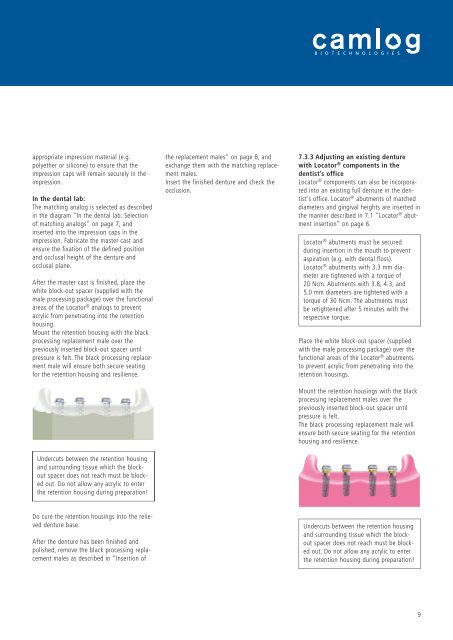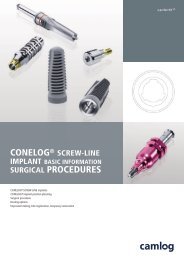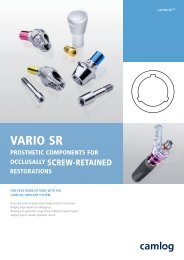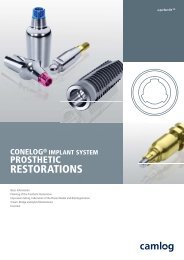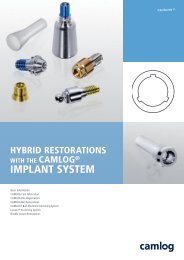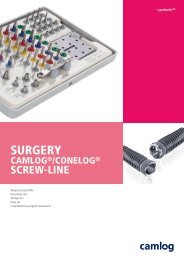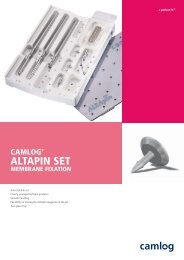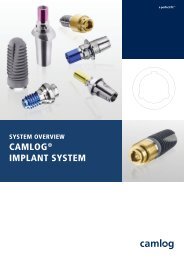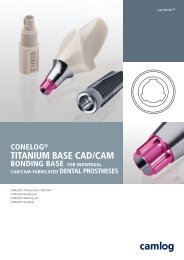Work Instruction for the Locator® Retentive System - Camlog
Work Instruction for the Locator® Retentive System - Camlog
Work Instruction for the Locator® Retentive System - Camlog
Create successful ePaper yourself
Turn your PDF publications into a flip-book with our unique Google optimized e-Paper software.
appropriate impression material (e.g.<br />
polye<strong>the</strong>r or silicone) to ensure that <strong>the</strong><br />
impression caps will remain securely in <strong>the</strong><br />
impression.<br />
In <strong>the</strong> dental lab:<br />
The matching analog is selected as described<br />
in <strong>the</strong> diagram "In <strong>the</strong> dental lab: Selection<br />
of matching analogs" on page 7, and<br />
inserted into <strong>the</strong> impression caps in <strong>the</strong><br />
impression. Fabricate <strong>the</strong> master cast and<br />
ensure <strong>the</strong> fixation of <strong>the</strong> defined position<br />
and occlusal height of <strong>the</strong> denture and<br />
occlusal plane.<br />
After <strong>the</strong> master cast is finished, place <strong>the</strong><br />
white block-out spacer (supplied with <strong>the</strong><br />
male processing package) over <strong>the</strong> functional<br />
areas of <strong>the</strong> Locator ® analogs to prevent<br />
acrylic from penetrating into <strong>the</strong> retention<br />
housing.<br />
Mount <strong>the</strong> retention housing with <strong>the</strong> black<br />
processing replacement male over <strong>the</strong><br />
previously inserted block-out spacer until<br />
pressure is felt. The black processing replacement<br />
male will ensure both secure seating<br />
<strong>for</strong> <strong>the</strong> retention housing and resilience.<br />
Undercuts between <strong>the</strong> retention housing<br />
and surrounding tissue which <strong>the</strong> blockout<br />
spacer does not reach must be blocked<br />
out. Do not allow any acrylic to enter<br />
<strong>the</strong> retention housing during preparation!<br />
Do cure <strong>the</strong> retention housings into <strong>the</strong> relieved<br />
denture base.<br />
After <strong>the</strong> denture has been finished and<br />
polished, remove <strong>the</strong> black processing replacement<br />
males as described in "Insertion of<br />
<strong>the</strong> replacement males" on page 8, and<br />
exchange <strong>the</strong>m with <strong>the</strong> matching replacement<br />
males.<br />
Insert <strong>the</strong> finished denture and check <strong>the</strong><br />
occlusion.<br />
7.3.3 Adjusting an existing denture<br />
with Locator ® components in <strong>the</strong><br />
dentist’s office<br />
Locator ® components can also be incorporated<br />
into an existing full denture in <strong>the</strong> dentist's<br />
office. Locator ® abutments of matched<br />
diameters and gingival heights are inserted in<br />
<strong>the</strong> manner described in 7.1 "Locator ® abutment<br />
insertion" on page 6.<br />
Locator ® abutments must be secured<br />
during insertion in <strong>the</strong> mouth to prevent<br />
aspiration (e.g. with dental floss).<br />
Locator ® abutments with 3.3 mm diameter<br />
are tightened with a torque of<br />
20 Ncm. Abutments with 3.8, 4.3, and<br />
5.0 mm diameters are tightened with a<br />
torque of 30 Ncm. The abutments must<br />
be retightened after 5 minutes with <strong>the</strong><br />
respective torque.<br />
Place <strong>the</strong> white block-out spacer (supplied<br />
with <strong>the</strong> male processing package) over <strong>the</strong><br />
functional areas of <strong>the</strong> Locator ® abutments<br />
to prevent acrylic from penetrating into <strong>the</strong><br />
retention housings.<br />
Mount <strong>the</strong> retention housings with <strong>the</strong> black<br />
processing replacement males over <strong>the</strong><br />
previously inserted block-out spacer until<br />
pressure is felt.<br />
The black processing replacement male will<br />
ensure both secure seating <strong>for</strong> <strong>the</strong> retention<br />
housing and resilience.<br />
Undercuts between <strong>the</strong> retention housing<br />
and surrounding tissue which <strong>the</strong> blockout<br />
spacer does not reach must be blocked<br />
out. Do not allow any acrylic to enter<br />
<strong>the</strong> retention housing during preparation!<br />
9


